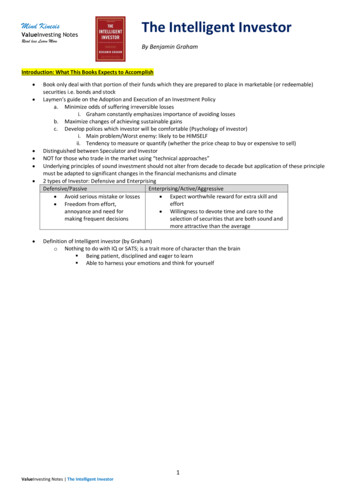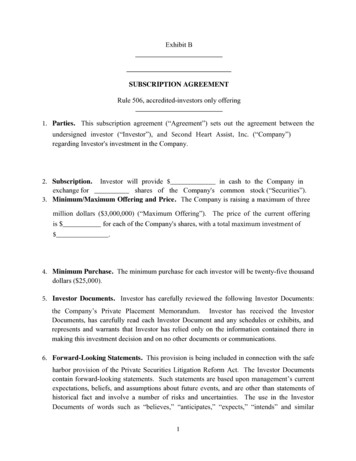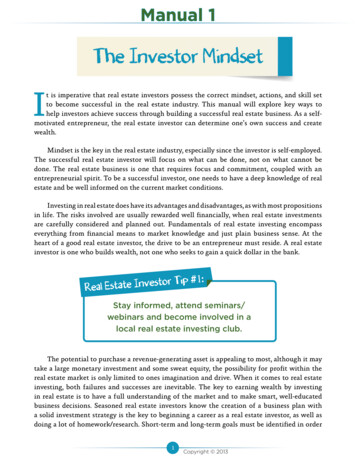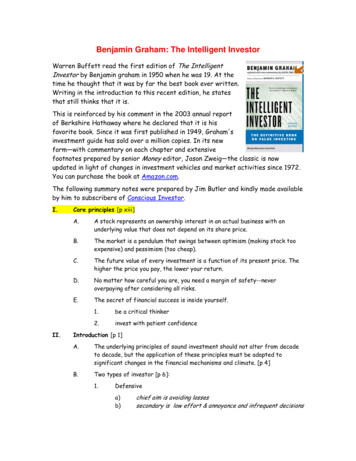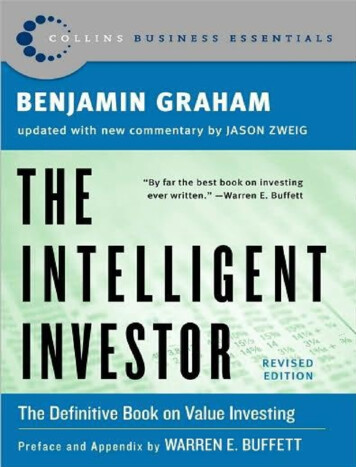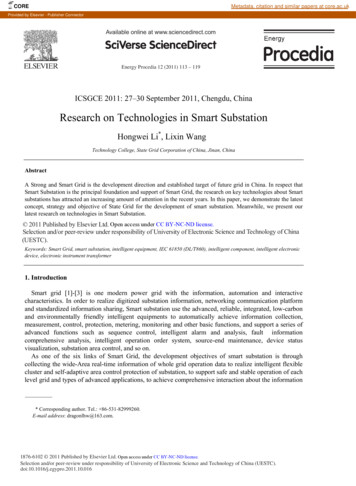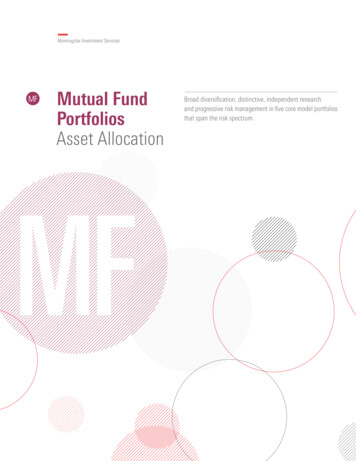
Transcription
THEINTELLIGENTINVESTORA BOOK OF PRACTICAL COUNSELREVISED EDITIONB E NJAM I N G RAHAMUpdated with New Commentary by Jason Zweig
To E.M.G.
Through chances various, through allvicissitudes, we make our way. . . .Aeneid
ContentsEpigraphPreface to the Fourth Edition, by Warren E. BuffettA Note About Benjamin Graham, by Jason ZweigxIntroduction: What This Book Expects to AccomplishCOMMENTARY ON THE INTRODUCTION1.2.3.4.6.7.8.iv112Investment versus Speculation: Results to BeExpected by the Intelligent Investor18COMMENTARY ON CHAPTER 135The Investor and Inflation47COMMENTARY ON CHAPTER 258A Century of Stock-Market History:The Level of Stock Prices in Early 197265COMMENTARY ON CHAPTER 380General Portfolio Policy: The Defensive Investor88COMMENTARY ON CHAPTER 45.iiiviii101The Defensive Investor and Common Stocks112COMMENTARY ON CHAPTER 5124Portfolio Policy for the Enterprising Investor:Negative Approach133COMMENTARY ON CHAPTER 6145Portfolio Policy for the Enterprising Investor:The Positive Side155COMMENTARY ON CHAPTER 7179The Investor and Market Fluctuations188
vContentsCOMMENTARY ON CHAPTER 89. Investing in Investment FundsCOMMENTARY ON CHAPTER 921322624210. The Investor and His Advisers257COMMENTARY ON CHAPTER 1027211. Security Analysis for the Lay Investor:General ApproachCOMMENTARY ON CHAPTER 1112. Things to Consider About Per-Share EarningsCOMMENTARY ON CHAPTER 1213. A Comparison of Four Listed CompaniesCOMMENTARY ON CHAPTER 1314. Stock Selection for the Defensive InvestorCOMMENTARY ON CHAPTER 1415. Stock Selection for the Enterprising InvestorCOMMENTARY ON CHAPTER 1516. Convertible Issues and WarrantsCOMMENTARY ON CHAPTER 1617. Four Extremely Instructive Case HistoriesCOMMENTARY ON CHAPTER 1718. A Comparison of Eight Pairs of CompaniesCOMMENTARY ON CHAPTER 1819. Shareholders and Managements: Dividend PolicyCOMMENTARY ON CHAPTER 1920. “Margin of Safety” as the Central Conceptof 38446473487497512COMMENTARY ON CHAPTER 20525Postscript532COMMENTARY ON POSTSCRIPT535Appendixes1. The Superinvestors of Graham-and-Doddsville537
Contentsvi2. Important Rules Concerning Taxability of InvestmentIncome and Security Transactions (in 1972)5613. The Basics of Investment Taxation(Updated as of 2003)5624. The New Speculation in Common Stocks5635. A Case History: Aetna Maintenance Co.5756. Tax Accounting for NVF’s Acquisition ofSharon Steel Shares5767. Technological Companies as Investments578Endnotes579Acknowledgments from Jason Zweig589Index591About the AuthorsCreditsFront CoverCopyrightAbout the PublisherThe text reproduced here is the Fourth Revised Edition, updated byGraham in 1971–1972 and initially published in 1973. Please beadvised that the text of Graham’s original footnotes (designated in hischapters with superscript numerals) can be found in the Endnotes section beginning on p. 579. The new footnotes that Jason Zweig has introduced appear at the bottom of Graham’s pages (and, in the typefaceused here, as occasional additions to Graham’s endnotes).
Preface to the Fourth Edition,by Warren E. BuffettI read the first edition of this book early in 1950, when I was nine-teen. I thought then that it was by far the best book about investingever written. I still think it is.To invest successfully over a lifetime does not require a stratospheric IQ, unusual business insights, or inside information.What’s needed is a sound intellectual framework for making decisions and the ability to keep emotions from corroding that framework. This book precisely and clearly prescribes the properframework. You must supply the emotional discipline.If you follow the behavioral and business principles that Graham advocates—and if you pay special attention to the invaluableadvice in Chapters 8 and 20—you will not get a poor result fromyour investments. (That represents more of an accomplishmentthan you might think.) Whether you achieve outstanding resultswill depend on the effort and intellect you apply to your investments, as well as on the amplitudes of stock-market folly that prevail during your investing career. The sillier the market’s behavior,the greater the opportunity for the business-like investor. FollowGraham and you will profit from folly rather than participate in it.To me, Ben Graham was far more than an author or a teacher.More than any other man except my father, he influenced my life.Shortly after Ben’s death in 1976, I wrote the following shortremembrance about him in the Financial Analysts Journal. As youread the book, I believe you’ll perceive some of the qualities I mentioned in this tribute.viii
ixPreface to the Fourth EditionBENJAMIN GRAHAM1894–1976Several years ago Ben Graham, then almost eighty, expressed to a friendthe thought that he hoped every day to do “something foolish, somethingcreative and something generous.”The inclusion of that first whimsical goal reflected his knack for packaging ideas in a form that avoided any overtones of sermonizing orself-importance. Although his ideas were powerful, their delivery wasunfailingly gentle.Readers of this magazine need no elaboration of his achievements asmeasured by the standard of creativity. It is rare that the founder of a discipline does not find his work eclipsed in rather short order by successors.But over forty years after publication of the book that brought structureand logic to a disorderly and confused activity, it is difficult to think of possible candidates for even the runner-up position in the field of securityanalysis. In an area where much looks foolish within weeks or monthsafter publication, Ben’s principles have remained sound—their value oftenenhanced and better understood in the wake of financial storms thatdemolished flimsier intellectual structures. His counsel of soundnessbrought unfailing rewards to his followers—even to those with naturalabilities inferior to more gifted practitioners who stumbled while following counsels of brilliance or fashion.A remarkable aspect of Ben’s dominance of his professional field wasthat he achieved it without that narrowness of mental activity that concentrates all effort on a single end. It was, rather, the incidental by-product ofan intellect whose breadth almost exceeded definition. Certainly I havenever met anyone with a mind of similar scope. Virtually total recall,unending fascination with new knowledge, and an ability to recast it in aform applicable to seemingly unrelated problems made exposure to histhinking in any field a delight.But his third imperative—generosity—was where he succeeded beyondall others. I knew Ben as my teacher, my employer, and my friend. In eachrelationship—just as with all his students, employees, and friends—therewas an absolutely open-ended, no-scores-kept generosity of ideas, time,and spirit. If clarity of thinking was required, there was no better place togo. And if encouragement or counsel was needed, Ben was there.Walter Lippmann spoke of men who plant trees that other men will situnder. Ben Graham was such a man.Reprinted from the Financial Analysts Journal, November/December 1976.
A Note About Benjamin Grahamby Jason ZweigWho was Benjamin Graham, and why should you listen to him?Graham was not only one of the best investors who ever lived; he wasalso the greatest practical investment thinker of all time. Before Graham,money managers behaved much like a medieval guild, guided largely bysuperstition, guesswork, and arcane rituals. Graham’s Security Analysiswas the textbook that transformed this musty circle into a modern profession.1And The Intelligent Investor is the first book ever to describe, forindividual investors, the emotional framework and analytical tools thatare essential to financial success. It remains the single best book oninvesting ever written for the general public. The Intelligent Investorwas the first book I read when I joined Forbes Magazine as a cubreporter in 1987, and I was struck by Graham’s certainty that, sooneror later, all bull markets must end badly. That October, U.S. stocks suffered their worst one-day crash in history, and I was hooked. (Today,after the wild bull market of the late 1990s and the brutal bear marketthat began in early 2000, The Intelligent Investor reads more prophetically than ever.)Graham came by his insights the hard way: by feeling firsthand theanguish of financial loss and by studying for decades the history andpsychology of the markets. He was born Benjamin Grossbaum onMay 9, 1894, in London; his father was a dealer in china dishes andfigurines.2 The family moved to New York when Ben was a year old. Atfirst they lived the good life—with a maid, a cook, and a French gov1Coauthored with David Dodd and first published in 1934.The Grossbaums changed their name to Graham during World War I,when German-sounding names were regarded with suspicion.2x
xiA Note About Benjamin Grahamerness—on upper Fifth Avenue. But Ben’s father died in 1903, theporcelain business faltered, and the family slid haltingly into poverty.Ben’s mother turned their home into a boardinghouse; then, borrowing money to trade stocks “on margin,” she was wiped out in the crashof 1907. For the rest of his life, Ben would recall the humiliation ofcashing a check for his mother and hearing the bank teller ask, “IsDorothy Grossbaum good for five dollars?”Fortunately, Graham won a scholarship at Columbia, where hisbrilliance burst into full flower. He graduated in 1914, second in hisclass. Before the end of Graham’s final semester, three departments—English, philosophy, and mathematics—asked him to join the faculty.He was all of 20 years old.Instead of academia, Graham decided to give Wall Street a shot.He started as a clerk at a bond-trading firm, soon became an analyst,then a partner, and before long was running his own investment partnership.The Internet boom and bust would not have surprised Graham. InApril 1919, he earned a 250% return on the first day of trading forSavold Tire, a new offering in the booming automotive business; byOctober, the company had been exposed as a fraud and the stockwas worthless.Graham became a master at researching stocks in microscopic,almost molecular, detail. In 1925, plowing through the obscurereports filed by oil pipelines with the U.S. Interstate Commerce Commission, he learned that Northern Pipe Line Co.—then trading at 65per share—held at least 80 per share in high-quality bonds. (Hebought the stock, pestered its managers into raising the dividend, andcame away with 110 per share three years later.)Despite a harrowing loss of nearly 70% during the Great Crash of1929–1932, Graham survived and thrived in its aftermath, harvestingbargains from the wreckage of the bull market. There is no exactrecord of Graham’s earliest returns, but from 1936 until he retired in1956, his Graham-Newman Corp. gained at least 14.7% annually,versus 12.2% for the stock market as a whole—one of the best longterm track records on Wall Street history.33Graham-Newman Corp. was an open-end mutual fund (see Chapter 9)that Graham ran in partnership with Jerome Newman, a skilled investor in hisown right. For much of its history, the fund was closed to new investors. I am
A Note About Benjamin GrahamxiiHow did Graham do it? Combining his extraordinary intellectualpowers with profound common sense and vast experience, Grahamdeveloped his core principles, which are at least as valid today as theywere during his lifetime: A stock is not just a ticker symbol or an electronic blip; it is anownership interest in an actual business, with an underlying valuethat does not depend on its share price.The market is a pendulum that forever swings between unsustainable optimism (which makes stocks too expensive) and unjustifiedpessimism (which makes them too cheap). The intelligent investoris a realist who sells to optimists and buys from pessimists.The future value of every investment is a function of its presentprice. The higher the price you pay, the lower your return will be.No matter how careful you are, the one risk no investor can evereliminate is the risk of being wrong. Only by insisting on whatGraham called the “margin of safety”—never overpaying, no matter how exciting an investment seems to be—can you minimizeyour odds of error.The secret to your financial success is inside yourself. If youbecome a critical thinker who takes no Wall Street “fact” on faith,and you invest with patient confidence, you can take steadyadvantage of even the worst bear markets. By developing yourdiscipline and courage, you can refuse to let other people’s moodswings govern your financial destiny. In the end, how your investments behave is much less important than how you behave.The goal of this revised edition of The Intelligent Investor is to applyGraham’s ideas to today’s financial markets while leaving his textentirely intact (with the exception of footnotes for clarification).4 Aftereach of Graham’s chapters you’ll find a new commentary. In thesereader’s guides, I’ve added recent examples that should show you justhow relevant—and how liberating—Graham’s principles remain today.grateful to Walter Schloss for providing data essential to estimatingGraham-Newman’s returns. The 20% annual average return that Grahamcites in his Postscript (p. 532) appears not to take management fees intoaccount.4The text reproduced here is the Fourth Revised Edition, updated by Graham in 1971–1972 and initially published in 1973.
xiiiA Note About Benjamin GrahamI envy you the excitement and enlightenment of reading Graham’smasterpiece for the first time—or even the third or fourth time. Like allclassics, it alters how we view the world and renews itself by educating us. And the more you read it, the better it gets. With Graham asyour guide, you are guaranteed to become a vastly more intelligentinvestor.
INTRODUCTION:What This Book Expects to AccomplishThe purpose of this book is to supply, in a form suitable for lay-men, guidance in the adoption and execution of an investment policy. Comparatively little will be said here about the technique ofanalyzing securities; attention will be paid chiefly to investmentprinciples and investors’ attitudes. We shall, however, provide anumber of condensed comparisons of specific securities—chiefly inpairs appearing side by side in the New York Stock Exchange list—in order to bring home in concrete fashion the important elementsinvolved in specific choices of common stocks.But much of our space will be devoted to the historical patternsof financial markets, in some cases running back over manydecades. To invest intelligently in securities one should be forearmed with an adequate knowledge of how the various types ofbonds and stocks have actually behaved under varying conditions—some of which, at least, one is likely to meet again in one’sown experience. No statement is more true and better applicable toWall Street than the famous warning of Santayana: “Those who donot remember the past are condemned to repeat it.”Our text is directed to investors as distinguished from speculators, and our first task will be to clarify and emphasize this now allbut forgotten distinction. We may say at the outset that this is not a“how to make a million” book. There are no sure and easy paths toriches on Wall Street or anywhere else. It may be well to point upwhat we have just said by a bit of financial history—especiallysince there is more than one moral to be drawn from it. In the climactic year 1929 John J. Raskob, a most important figure nationallyas well as on Wall Street, extolled the blessings of capitalism in anarticle in the Ladies’ Home Journal, entitled “Everybody Ought to Be1
2IntroductionRich.”* His thesis was that savings of only 15 per month investedin good common stocks—with dividends reinvested—would produce an estate of 80,000 in twenty years against total contributionsof only 3,600. If the General Motors tycoon was right, this wasindeed a simple road to riches. How nearly right was he? Ourrough calculation—based on assumed investment in the 30 stocksmaking up the Dow Jones Industrial Average (DJIA)—indicatesthat if Raskob’s prescription had been followed during 1929–1948,the investor’s holdings at the beginning of 1949 would have beenworth about 8,500. This is a far cry from the great man’s promiseof 80,000, and it shows how little reliance can be placed on suchoptimistic forecasts and assurances. But, as an aside, we shouldremark that the return actually realized by the 20-year operationwould have been better than 8% compounded annually—and thisdespite the fact that the investor would have begun his purchaseswith the DJIA at 300 and ended with a valuation based on the 1948closing level of 177. This record may be regarded as a persuasiveargument for the principle of regular monthly purchases of strongcommon stocks through thick and thin—a program known as“dollar-cost averaging.”Since our book is not addressed to speculators, it is not meantfor those who trade in the market. Most of these people are guidedby charts or other largely mechanical means of determining theright moments to buy and sell. The one principle that applies tonearly all these so-called “technical approaches” is that one shouldbuy because a stock or the market has gone up and one should sellbecause it has declined. This is the exact opposite of sound businesssense everywhere else, and it is most unlikely that it can lead to* Raskob (1879–1950) was a director of Du Pont, the giant chemical company, and chairman of the finance committee at General Motors. He alsoserved as national chairman of the Democratic Party and was the drivingforce behind the construction of the Empire State Building. Calculations byfinance professor Jeremy Siegel confirm that Raskob’s plan would havegrown to just under 9,000 after 20 years, although inflation would haveeaten away much of that gain. For the best recent look at Raskob’s views onlong-term stock investing, see the essay by financial adviser William Bernstein at www.efficientfrontier.com/ef/197/raskob.htm.
What This Book Expects to Accomplish3lasting success on Wall Street. In our own stock-market experienceand observation, extending over 50 years, we have not known asingle person who has consistently or lastingly made money bythus “following the market.” We do not hesitate to declare that thisapproach is as fallacious as it is popular. We shall illustrate whatwe have just said—though, of course this should not be taken asproof—by a later brief discussion of the famous Dow theory fortrading in the stock market.*Since its first publication in 1949, revisions of The IntelligentInvestor have appeared at intervals of approximately five years. Inupdating the current version we shall have to deal with quite anumber of new developments since the 1965 edition was written.These include:1.2.3.4.An unprecedented advance in the interest rate on high-gradebonds.A fall of about 35% in the price level of leading commonstocks, ending in May 1970. This was the highest percentagedecline in some 30 years. (Countless issues of lower qualityhad a much larger shrinkage.)A persistent inflation of wholesale and consumer’s prices,which gained momentum even in the face of a decline of general business in 1970.The rapid development of “conglomerate” companies, franchise operations, and other relative novelties in business andfinance. (These include a number of tricky devices such as “letter stock,” 1 proliferation of stock-option warrants, misleadingnames, use of foreign banks, and others.)†* Graham’s “brief discussion” is in two parts, on p. 33 and pp. 191–192.For more detail on the Dow Theory, see �� Mutual funds bought “letter stock” in private transactions, then immediately revalued these shares at a higher public price (see Graham’s definitionon p. 579). That enabled these “go-go” funds to report unsustainably highreturns in the mid-1960s. The U.S. Securities and Exchange Commissioncracked down on this abuse in 1969, and it is no longer a concern for fundinvestors. Stock-option warrants are explained in Chapter 16.
45.6.IntroductionBankruptcy of our largest railroad, excessive short- and longterm debt of many formerly strongly entrenched companies,and even a disturbing problem of solvency among Wall Streethouses.*The advent of the “performance” vogue in the management ofinvestment funds, including some bank-operated trust funds,with disquieting results.These phenomena will have our careful consideration, and somewill require changes in conclusions and emphasis from our previous edition. The underlying principles of sound investment shouldnot alter from decade to decade, but the application of these principles must be adapted to significant changes in the financial mechanisms and climate.The last statement was put to the test during the writing of thepresent edition, the first draft of which was finished in January1971. At that time the DJIA was in a strong recovery from its 1970low of 632 and was advancing toward a 1971 high of 951, withattendant general optimism. As the last draft was finished, inNovember 1971, the market was in the throes of a new decline, carrying it down to 797 with a renewed general uneasiness about itsfuture. We have not allowed these fluctuations to affect our generalattitude toward sound investment policy, which remains substantially unchanged since the first edition of this book in 1949.The extent of the market’s shrinkage in 1969–70 should haveserved to dispel an illusion that had been gaining ground during the past two decades. This was that leading common stockscould be bought at any time and at any price, with the assurance notonly of ultimate profit but also that any intervening loss would soonbe recouped by a renewed advance of the market to new high lev-* The Penn Central Transportation Co., then the biggest railroad in theUnited States, sought bankruptcy protection on June 21, 1970—shockinginvestors, who had never expected such a giant company to go under (seep. 423). Among the companies with “excessive” debt Graham had in mindwere Ling-Temco-Vought and National General Corp. (see pp. 425 and463). The “problem of solvency” on Wall Street emerged between 1968and 1971, when several prestigious brokerages suddenly went bust.
What This Book Expects to Accomplish5els. That was too good to be true. At long last the stock market has“returned to normal,” in the sense that both speculators and stockinvestors must again be prepared to experience significant and perhaps protracted falls as well as rises in the value of their holdings.In the area of many secondary and third-line common stocks,especially recently floated enterprises, the havoc wrought by thelast market break was catastrophic. This was nothing new initself—it had happened to a similar degree in 1961–62—but therewas now a novel element in the fact that some of the investmentfunds had large commitments in highly speculative and obviouslyovervalued issues of this type. Evidently it is not only the tyro whoneeds to be warned that while enthusiasm may be necessary forgreat accomplishments elsewhere, on Wall Street it almost invariably leads to disaster.The major question we shall have to deal with grows out of thehuge rise in the rate of interest on first-quality bonds. Since late 1967the investor has been able to obtain more than twice as muchincome from such bonds as he could from dividends on representative common stocks. At the beginning of 1972 the return was 7.19%on highest-grade bonds versus only 2.76% on industrial stocks.(This compares with 4.40% and 2.92% respectively at the end of1964.) It is hard to realize that when we first wrote this book in 1949the figures were almost the exact opposite: the bonds returned only2.66% and the stocks yielded 6.82%.2 In previous editions we haveconsistently urged that at least 25% of the conservative investor’sportfolio be held in common stocks, and we have favored in generala 50–50 division between the two media. We must now considerwhether the current great advantage of bond yields over stockyields would justify an all-bond policy until a more sensible relationship returns, as we expect it will. Naturally the question of continued inflation will be of great importance in reaching our decisionhere. A chapter will be devoted to this discussion.** See Chapter 2. As of the beginning of 2003, U.S. Treasury bonds maturing in 10 years yielded 3.8%, while stocks (as measured by the Dow JonesIndustrial Average) yielded 1.9%. (Note that this relationship is not all thatdifferent from the 1964 figures that Graham cites.) The income generatedby top-quality bonds has been falling steadily since 1981.
6IntroductionIn the past we have made a basic distinction between two kindsof investors to whom this book was addressed—the “defensive”and the “enterprising.” The defensive (or passive) investor willplace his chief emphasis on the avoidance of serious mistakes orlosses. His second aim will be freedom from effort, annoyance, andthe need for making frequent decisions. The determining trait ofthe enterprising (or active, or aggressive) investor is his willingnessto devote time and care to the selection of securities that are bothsound and more attractive than the average. Over many decadesan enterprising investor of this sort could expect a worthwhilereward for his extra skill and effort, in the form of a better averagereturn than that realized by the passive investor. We have somedoubt whether a really substantial extra recompense is promised tothe active investor under today’s conditions. But next year or theyears after may well be different. We shall accordingly continue todevote attention to the possibilities for enterprising investment, asthey existed in former periods and may return.It has long been the prevalent view that the art of successful investment lies first in the choice of those industries thatare most likely to grow in the future and then in identifying themost promising companies in these industries. For example, smartinvestors—or their smart advisers—would long ago have recognized the great growth possibilities of the computer industry as awhole and of International Business Machines in particular. Andsimilarly for a number of other growth industries and growth companies. But this is not as easy as it always looks in retrospect. Tobring this point home at the outset let us add here a paragraph thatwe included first in the 1949 edition of this book.Such an investor may for example be a buyer of air-transportstocks because he believes their future is even more brilliant thanthe trend the market already reflects. For this class of investor thevalue of our book will lie more in its warnings against the pitfallslurking in this favorite investment approach than in any positivetechnique that will help him along his path.** “Air-transport stocks,” of course, generated as much excitement in the late1940s and early 1950s as Internet stocks did a half century later. Amongthe hottest mutual funds of that era were Aeronautical Securities and the
What This Book Expects to Accomplish7The pitfalls have proved particularly dangerous in the industrywe mentioned. It was, of course, easy to forecast that the volume ofair traffic would grow spectacularly over the years. Because of thisfactor their shares became a favorite choice of the investmentfunds. But despite the expansion of revenues—at a pace evengreater than in the computer industry—a combination of technological problems and overexpansion of capacity made for fluctuating and even disastrous profit figures. In the year 1970, despite anew high in traffic figures, the airlines sustained a loss of some 200 million for their shareholders. (They had shown losses also in1945 and 1961.) The stocks of these companies once again showed agreater decline in 1969–70 than did the general market. The recordshows that even the highly paid full-time experts of the mutualfunds were completely wrong about the fairly short-term future ofa major and nonesoteric industry.On the other hand, while the investment funds had substantialinvestments and substantial gains in IBM, the combination of itsapparently high price and the impossibility of being certain aboutits rate of growth prevented them from having more than, say, 3%of their funds in this wonderful performer. Hence the effect ofthis excellent choice on their overall results was by no meansdecisive. Furthermore, many—if not most—of their investments incomputer-industry companies other than IBM appear to have beenunprofitable. From these two broad examples we draw two moralsfor our readers:1.2.Obvious prospects for physical growth in a business do nottranslate into obvious profits for investors.The experts do not have dependable ways of selecting andconcentrating on the most promising companies in the mostpromising industries.Missiles-Rockets-Jets & Automation Fund. They, like the stocks they owned,turned out to be an investing disaster. It is commonly accepted today thatthe cumulative earnings of the airline industry over its entire history havebeen negative. The lesson Graham is driving at is not that you should avoidbuying airline stocks, but that you should never succumb to the “certainty”that any industry will outperform all others in the future.
8IntroductionThe author did not follow this approach in his financial career asfund manager, and he cannot offer either specific counsel or muchencouragement to those who may wish to try it.What then will we aim to accomplish in this book? Our mainobjective will be to guide the reader against the areas of possiblesubstantial error and to develop policies with which he will becomfortable. We shall say quite a bit about the psychology ofinvestors. For indeed, the investor’s chief problem—and even hisworst enemy—is likely to be himself. (“The fault, dear
10. The Investor and His Advisers 257 COMMENTARY ON CHAPTER 10 272 11. Security Analysis for the Lay Investor: General Approach 280 COMMENTARY ON CHAPTER 11 302 12. Things to Consider About Per-Share Earnings 310 COMMENTARY ON CHAPTER 12 322 13. A Comparison of Four Listed Companies 330 COMMENTARY ON CHAPTER 13 339 14. Stock Selection for the .

